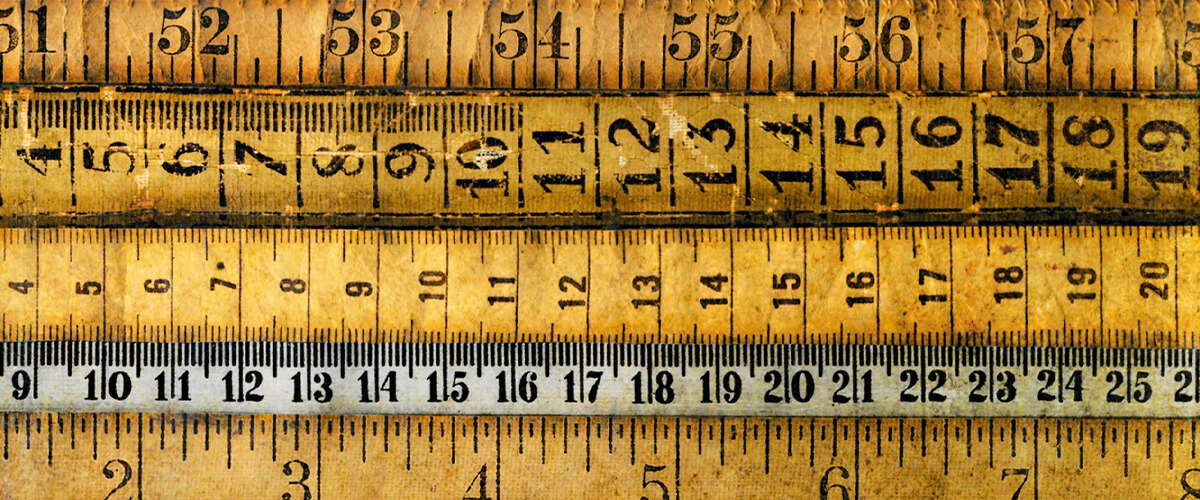Imperial or metric? The choice seems simple, but it's not! Learn how the french revolution created the metric system and why your tallest friend should do your shopping.
TL;DR
Weight and measurement systems date back to prehistoric times...
They varied wildly by area and location. Early measuring systems used grains, seeds, and various body parts to establish measurements. These systems had a large room for error. The monarchy first standardized sizes. The French revolution allowed scientists to change this to a more “logical” decimal system: the meter, kilogram, and liter. Most countries use this system. However, the USA still uses the imperial system established in the 1800s.
Imperial or Metric?
If you're in the US, you'll probably fill your car with 11 gals of gas, drive 8 mi to work, weigh 150 lbs, and use a 1/2" screw to fix your fence.
Over on the European continent, you'll fill your car with 43 l of gas, drive 12 km, weigh yourself at 68 kg, and use a 12.5 mm screw to fix your fence.
Meanwhile, in Britain,n you'll fill your car with 43 l of petrol, drive 8 mi to work, weigh yourself at 10 st 7 lb,s and use a 12.5 mm screw to fix your fence.
Normally this only leads to mild confusion, but sometimes the implications are more serious. Famously NASA lost the Mars Climate Orbiter due to a mix-up of imperial and metric units.
If you are working with BricsCAD, but sure to follow our complete guide to switching between drawing units.
Rough conversion chart:
- 1 mi = 1.6 km.
- 1" = 25 mm/2.54 cm
- 3 ft = 1 m
- 1 kg = 2 lbs
- 1 lb = 454 g
- For Brits: 100lbs = 7 st 2lbs
- 1 imperial gal = 1.2 US gal
So what's going o,n and why is there all this confusion?
They have different measurements based on geographical location familiar. For as long as humans have been trading, they have been measuring. The earliest examples of weights and measures date back to 4ththe millennium BC; you guessed it, these measurements were localized.

Photo of Mesopotamian weights made from haematite. The largest weighsone1 mina (499 g), and the smallest 3 shekels (34.26 g) Geni [CC BY-SA 4.0], via Wikimedia Commons
Arms, grains, and paces
In the early days, objects with relative stability, such as seeds and grains, were used to measure weight and volume. The carat, a measure we still use for precious stones, is derived from ob seed! The problem was that counting the number of sources totoillurcesd took a long time.
Using body parts as a means of the measure was also commonplace. The Egyptians, along with the ancient Indians and the Mesopota, used a cubit, equivalent to the elbow's lenlengtho the tip of the middle finger. However, using it as a standard measure is fatfatally flawedlect your friend with the most extended arms to go shopping for you. The Egyptians'solutions was to create a standard rod with the measurements marked.

Fragment of a Cubit measuring stick. Image credit: Metropolitan Museum of Art [CC0], via Wikimedia Commons
The same problem was true for a yard. Originally this was the length of a man's belt. Finally, an excuse for overindulgence!
The Romans introduced the mile passus measure (1000 paces -- a double step). This fell about 280 ft (85 m) short of the modern mile. Again, if you've seen a small and tall person walking together, you will understand the room for error in this measurement.
The Imperial System
The British imperial system, the origin of the US imperial system, originated in the 10th century with the Saxon king Edgar the Peaceable and took on the name "Winchester.”. He standardized a bushel ( 35.2 l or 9.3 US g Beforeoreo this, traditional terms such as "foot" and "gallon" were used, but the usage of the words was somewhat blasé. The actual values of these measures varied wildly depending on the place, time, and even the commodity being traded.

The Standard for Imperial Measurement, Trafalgar Square. John Winfield / The standard for Imperial Measurement, via Wikimedia Commons
In the 1400s, the first yard was recorded as 3 ft, a foot equal to 12 ", and each inch being the length of 3 barleycorns, replacing the previous measurement (the width of a man's thumb). Later, in the 1500s, King Henry VII re-standardized the Winchester standards. He then distributed standard measures across the kingdom to uphold the new system.
By the 1700s, the acre rod anand furlongeree set as we now know them. At the same time, the vast number of "pound" measurements had been reduced to just 2: the troy pound (precious metals, jewels, and drugs) and the pound avoirdupois, also known as the 'wool pound.’
British Imperial versus US Imperial
In 1824, an act established the British Imperial system, and another show in 1878, more accurately defined the measurements.
The US metric system is based on the 1824 system, which is why the US gallon is about 17% smaller than its British Imperial counterpart. It's also interesting to note that British volumes for units of dry and liquid are the same, while the US dry pint is around 15% larger.
Then there is the interesting quirk of the ton. In British Imperial units, the hundredweight is 2,240 pounds, while in the US, it's 2000 pounds. That's because the British used the stone measurement (14 pounds), a size set by King Edward III in 1350. This measurement defines the "hundredweight" as 112 and 100, respectively.

Traditionally, live animals were weighed at 14 lbs to the stone, while butchered carcasses were weighed at 8 lbs to the stone. This allowed the butcher to keep the offal and return the animal at the "same weight" to the owner.
Despite adopting the metric system in the UK, the Statutory Instrument 1995 No. 1804 allows the use of the mile, yard, foot, or inch for road traffic signs in the UK. This is primarily thought to be due to the cost implications of the country-wide conversion.
The Metric System
The metric system, originally called the decimal system, can trace its origins back to the French revolution of 1789. The idea was to replace all confusing and irregular measurements with a "rational system" based on multiples of 10. At the time, up to 250,000 units of weight and length were ususedusually defined by the local aristocracy to suit their needs. The revolutionist saw the new system as a way of freeing themselves.

A computer-generated version of the original Platinum Iridium meter bar.
In 1791 the French Academy of Sciences declared that this new system should be based on the length of 1/10,000,000 of a quadrant of the earth. It was measured, of course, as it passed through Paris. The final established measurement was 1 meter = 39.37008 inches.
Measuring the earth was a complex task. The tale of the two astronomers: Jean-Baptiste Delambre and Pierre Méchain, is colorful, varied, and spread over six years. It represents a unique moment in the history of science. The pair were imprisoned as spies, royalists, and sorcerers, due to their strange behavior: climbing towers, mountains, and churches with bizarre-looking instruments. Although Méchain realized he had made an error in his measurements, the initially established meter remains unchanged. It lives on as a testimony to their endeavor.
The newly established meter was combined with water to develop the other metric measurements we know today: 1 l = 1 kg = 0.001 m3 of water at four °C (39,2°F).
In 1959, most major world countries adopted the metric system.
The following year, in 1960, the meter was redefined as 1,650,763.73 wavelengths of the orange-red line in the krypton-86 spectrum. It is now defined as the distance traveled by light in a vacuum in 1/299,792,458 seconds, a measurement established in 1983.
Make sure your CAD drawings measure up with BricsCAD
Download BricsCAD Free Trial | Sign Up For News & Updates | Shop Online For BricsCAD Desktop Software

